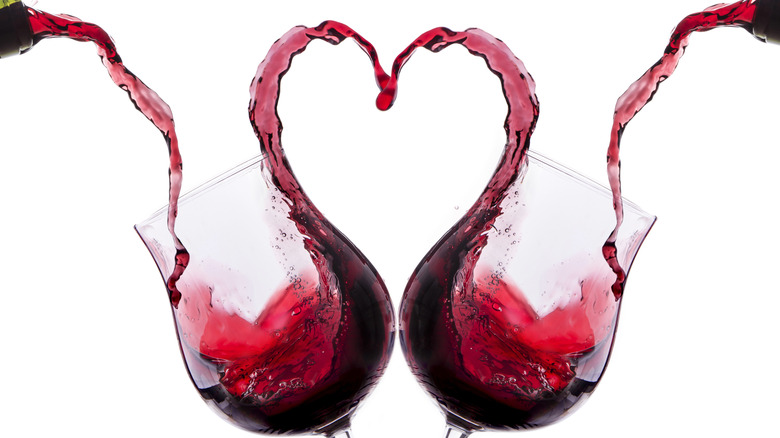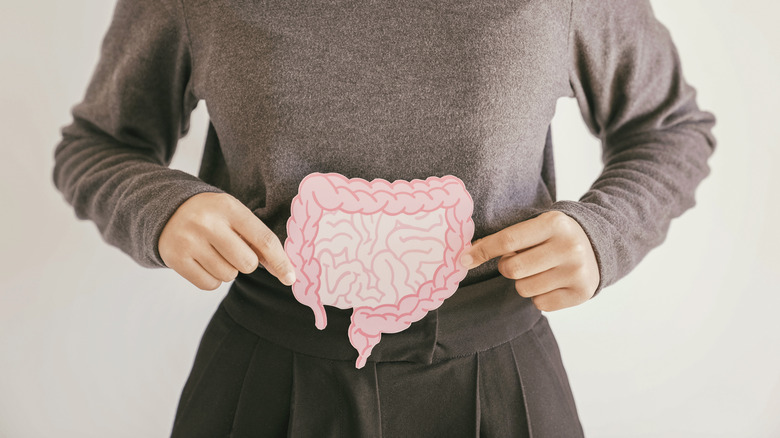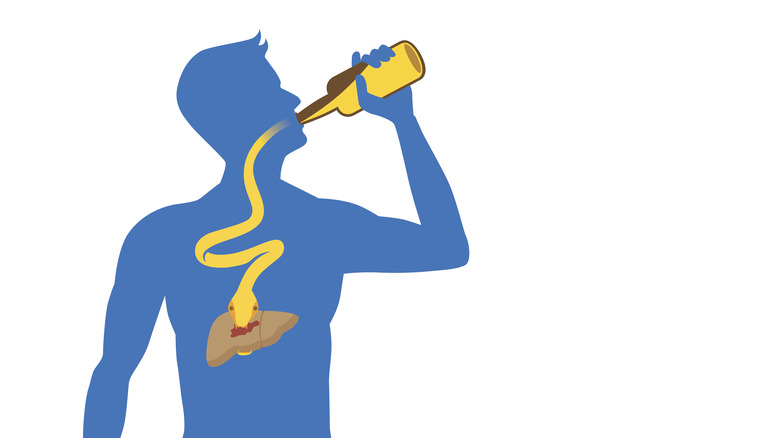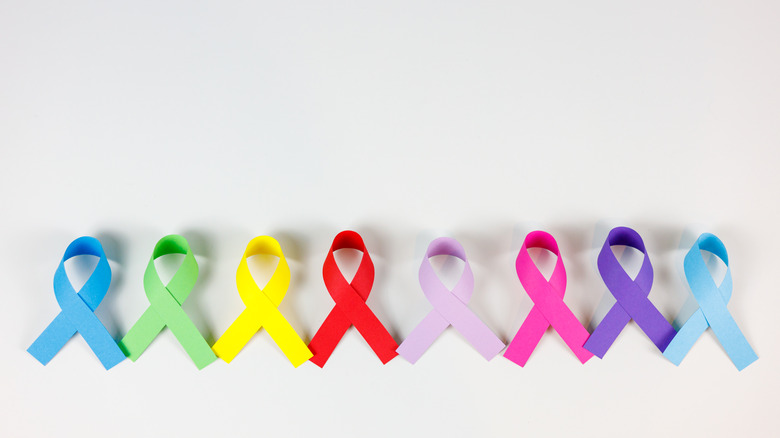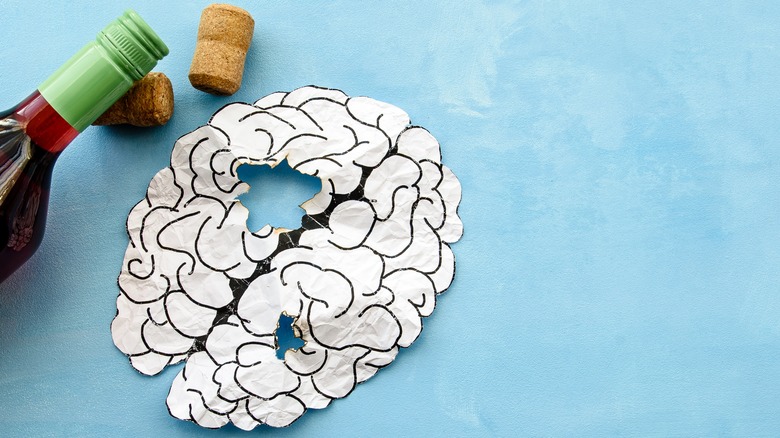Unexpected Health Benefits Of Drinking Red Wine
Is drinking alcohol just a product of societal pressures and mainstream media influence? Or is there more to it than meets the eye?
Alcohol is made by fermenting grains and fruits, a practice that can be dated back as early as 9,000 years ago in Northern China. During these ancient times, there is also evidence that alcohol was used in ceremonial, cultural, medical, religious, and social activities by several groups of people, including the Egyptians, Greeks, Romans, and Sumerians. Fast forward to the 1600s, the English came to America and brought distilled spirits (aka liquor) with them, and by the 1800s, alcohol was completely integrated into American culture.
It is no question that many people drink alcohol — or at least have at some point. According to the National Institute on Alcohol Abuse and Alcoholism (NIAAA), among Americans aged 12 years and older, 78.3% have drunk alcohol at least once in their lifetime, 21.5% have gone binge drinking (blood alcohol concentration of 0.08% or more) in the past month, and 5.8% (equivalent to 16.3 million people) have consumed alcohol heavily in the past month. While most people tend to drink different types of alcohol, it turns out that 22% prefer to drink beer only, 17% prefer to drink wine only, and 14% prefer to drink liquor only. Interestingly, most beer and liquor consumers are men, while most wine consumers are women (per PennState Extension).
Red wine explained
Wine comes primarily from fermenting grapes, but the alcohol that comes from fermenting other types of fruits are also sometimes referred to as wine (e.g., blueberry wine, elderberry wine). In general though, wine is primarily categorized as red wine or white wine. Wines are labeled based on their region of origin, how ripe their fruits were, and/or the variety of grape they're made from. For example, Cabernet Sauvignon, Merlot, Chardonnay, and Pinot Noir are all named after regions in France, while Kabinett, Auslese, and Beerenauslese from Germany correspond to the wine's sweetness level.
According to Wine.com, red wine can be dry or sweet. A glass (5 ounces) of dry red wine only has around 120 to 130 calories, and 0 to 4 grams of carbohydrates. Meanwhile, a serving (2 ounces) of sweet wine has around 100 calories, and significantly more carbohydrates that can reach up to 220 grams per 5 ounces (via Wine Folly).
Red wine's claim to fame in the health industry began in the 1990s, when a paper published in the American Journal of Enology and Viticulture stated that certain types of red wine contained significant amounts of resveratrol — a compound that was already postulated to have protective effects on the heart. Because of this, research on red wine and resveratrol grew tremendously, with studies showing resveratrol as a powerful antioxidant that has anti-inflammatory, anti-aging, and anti-cancer properties (via Cleveland Clinic).
How much is too much alcohol?
Wouldn't it be nice if we lived in a world where we could eat or drink anything we want without having to worry about the potential harms it could do to our health? Unfortunately, that is not the way the world works. And while it is great that researchers have found a possible benefit to drinking one of the world's favorite alcoholic beverages, it does not mean that it is good to drink it in large quantities.
While there is no such thing as drinking too little alcohol, there is such a thing as drinking too much. As recommended in the Dietary Guidelines for Americans, it is better for people who do not drink alcohol to continue staying away from alcohol. If you do drink alcohol, you should be at least 21 years old, and you should try to limit your intake below the recommended amount. Women should only have one drink or less per day, and men should only have two drinks or less per day. This quota resets every day, which means that you cannot abstain from drinking for a specific period of time, only to drink what you "missed" on those days in one sitting. A drink is defined as a beverage containing 0.6 fluid ounces of pure alcohol, which is equivalent to about 12 fluid ounces of 5% regular beer, 5 fluid ounces of 12% wine, 1.5 fluid ounces of 40% distilled spirit, or 8 fluid ounces of 7% malt liquor.
Red wine and its effects on the cardiovascular system
Resveratrol — the antioxidant that can be found in grapes, berries, cocoa, and peanuts — is one of the main reasons behind the claims that drinking red wine is good for your heart. According to Harvard, it began with the French Paradox. It is based on the observation that heart disease is relatively low among the French, despite their diet being rich in cheese and other fatty foods. Somehow, this observation got linked to the fact that they drink a lot of wine as part of their regular diet, and this encouraged researchers to look into grapes, where they found healthy plant compounds called polyphenols.
Resveratrol is a polyphenol, along with flavonoids and tannins. Per a 2019 review published in Molecules, collective research studies show that these compounds and their metabolites are biologically active and able to prevent cholesterol deposition in arteries, decrease bad cholesterol in the blood, improve heart function, lessen oxidative stress, and reduce inflammation. In relation to this, several studies and meta-analyses have also linked light to moderate drinking of red wine to a decreased risk of developing coronary heart disease and atherosclerosis.
The caveat to these observations however is the fact that the molecular composition of red wine can vary greatly depending on many factors (e.g., environmental conditions, wine-making processes). Unless we test every single bottle of wine for its polyphenol content, we will never know exactly how much is in there. Additionally, some experts believe that the cardioprotective effects associated with red wine may also be explained by other unrelated factors, such as an individual's dietary and lifestyle habits.
It may help control blood pressure
According to the Centers for Disease Control and Prevention (CDC), close to half (48.1%) of adults in the United States have high blood pressure and/or are taking blood pressure medications. But just because something is common, does not mean that it is not serious. Having uncontrolled high blood pressure can give rise to a number of other health problems, including heart disease, heart failure, stroke, kidney disease, vision loss, peripheral artery disease, cognitive impairment, and sexual dysfunction (via Healthgrades).
While it is still unknown what causes a person to develop high blood pressure, there are certain factors that have been shown to increase a person's risk. Such factors include older age, race, positive family history, physical inactivity, obesity, smoking, too much salt intake, stress, and excessive alcohol consumption (via Mayo Clinic). Given this, why do some studies suggest that drinking red wine helps decrease blood pressure if drinking alcohol can increase your risk of developing high blood pressure?
A 2021 review and meta-analysis published in Pharmacological Research found that supplementation with phytochemicals, specifically proanthocyanidins, significantly reduced blood pressure in several randomized controlled trials. These phytochemicals can be found in several fruits and vegetables — and can also be found in red wine, since red wine is made from grapes. This indirectly suggests that drinking red wine may help decrease blood pressure. However, because of the associated risks of drinking too much alcohol, Medical News Today suggests a healthier alternative: eating grapes or drinking whole grape juice.
Red wine may lower the risk of type 2 diabetes
The CDC estimates that there are 37 million (around 1 out of 10) people with diabetes in the United States, and approximately 96 million (more than 1 out of 3) people with prediabetes. Complications associated with having uncontrolled blood sugar are similar to the complications associated with having uncontrolled hypertension, which include heart disease, stroke, kidney failure, vision loss, and leg problems.
Drinking alcohol for people with diabetes can also get confusing. On one hand, some drinks (especially cocktails with added syrups and sweet wines) are loaded with sugar, which is a big no-no for diabetics. But on the other hand, the American Diabetes Association (ADA) states that one to two alcoholic drinks a day may lower blood sugar — and even improve the body's sensitivity to insulin.
Apart from its possible effects on blood sugar levels, other ways alcohol (red wine specifically) may be able to help people with diabetes is through its effect on the heart and lipid levels. As previously mentioned, some research has suggests that light to moderate consumption of red wine can decrease the risk of developing heart disease. Studies have also shown that moderate red wine consumption can increase good cholesterol levels and decrease total cholesterol levels in the blood (per Healthline).
Red wine and your gut health
The gut has taken the spotlight for its important role in our overall health. Contrary to what we previously believed, our gut is not only responsible for digestion, but it actually houses a whole colony of various microorganisms, collectively known as the gut microbiome. They are primarily found in the intestines, which surprisingly is where most of our immune-producing cells are located. Some of these microbes also help produce substances that we need to stay healthy, such as enzymes, hormones, and vitamins. Because of this, the gut microbiome is said to have effects on other areas throughout our body as well (via Cleveland Clinic).
A 2018 review published in Diseases found that red wine possesses prebiotic effects and is able to increase the diversity of beneficial microorganisms in the gut. This mirrors the results from another 2018 review published in Food Research International. The authors found that polyphenols found in grapes and red wine are responsible for their beneficial effects on the gut microbiome, and that the gut microbiome is also able to regulate polyphenol compounds, creating an almost mutualistic effect.
In a 2019 cohort study published in Gastroenterology, researchers looked into the effect of several types of alcohol on the gut microbiome, including beer, cider, red wine, white wine, and spirits. All of their participants were female. They found that study participants who drank more red wine had a more diverse gut microbiome. However, even those who only drank a little bit of red wine experienced a beneficial effect on their gut microbiome diversity. Those who drank white wine also showed some effect. No changes were seen with the other alcoholic beverages.
Does it cause liver disease? Or protect against it?
Excessive alcohol consumption has already been established as a risk factor for liver disease. This makes sense because the liver is the organ responsible for processing and clearing alcohol from the body. Our bodies were never built to process large quantities of alcohol, and like any other organ in the body, the liver can only take so much. As Johns Hopkins Medicine explains, making our liver work overtime can cause it to enlarge and accumulate fat (i.e., alcoholic fatty liver disease) or become acutely inflamed (i.e., alcoholic hepatitis). Eventually, the liver cells can die and leave scar tissue (i.e., liver cirrhosis), and over time it may progress to liver failure.
Interestingly, moderate red wine consumption seems to have the opposite effect. Authors of a small 2018 study published in the American Journal of Gastroenterology looked into patients with non-alcoholic fatty liver disease (NAFLD) who were undergoing liver biopsy. They found that those who exclusively drank wine showed a lower stage of liver fibrosis (scarring) and a lower risk of progressing to advanced fibrosis compared to those who never drank alcohol.
A separate 2018 review published in Molecules had similar findings. The authors found that resveratrol, a compound found in red wine, may be helpful in protecting against fibrosis of the liver, and may even protect against the development of liver cancer. Additionally, in animal experiments, resveratrol was able to significantly reduce the number of liver cancer cells in rats, prevent weight loss, and decrease liver enzyme levels.
Effect of red wine on cancer risk and progression
Alcohol and cancer have somewhat of a complicated relationship. According to the National Cancer Institute (NCI), consumption of alcohol has been strongly associated with an increased risk of certain types of cancer. These include cancers of the breast, esophagus, head and neck, liver, colon, and rectum. Research also shows that the more alcohol you drink, the higher your risk of developing these cancer types. It is still unclear how exactly this happens, but it may be due to the tendency of alcohol to cause oxidative stress, DNA damage, impaired absorption of nutrients, and increased estrogen levels (seen in breast cancer).
On the other hand, several studies have suggested that drinking red wine may potentially protect against certain cancers — and may even potentiate the effects of some chemotherapy drugs. A 2017 review published in Nutrients looked into the anti-lung cancer properties of resveratrol, a compound that can be found in red wine. They found that resveratrol can prevent the growth of tumors, decrease the proliferation of cancer cells, induce the death of certain cancer cells, and prevent lung cancer from spreading.
Another study, published in 2019 in the Journal of Clinical Oncology, involved over 50,000 male participants between 40 to 75 years old. The researchers found that among the men with existing prostate cancer, those who drank red wine had a lower risk of the disease progressing to a deadly form.
It is important to note however that the evidence linking alcohol intake to an increased risk of cancer is stronger and more widely accepted by experts.
How does it affect the brain?
One of the most common health conditions that can affect the brain is dementia. While dementia is typically understood as a decline in a person's cognitive ability, it is actually an umbrella term that refers to several different diseases that can manifest uniquely from one another. Some of the most well-known examples of dementia include Alzheimer's disease, Parkinson's disease, and Huntington's disease (per Dementia.org).
Heavy alcohol use is associated with an increased risk of developing dementia early in life. It can also put a person at risk of trauma (e.g., head injuries from a fall or car accident), which can damage the brain and possibly progress to dementia as well (via the American Addiction Centers).
Interestingly, a 2018 study published in the British Medical Journal (BMJ) found that participants who abstained from alcohol during their midlife, abstained from alcohol long-term, or decreased their alcohol consumption had a significantly higher risk of developing dementia compared to those who continued to drink alcohol in moderation. This observation was only applicable to participants who abstained from wine and not other types of alcoholic beverages. The authors also found that participants who drank wine in moderation had a lower risk of developing dementia. This finding mimics that of the results from a 2015 study published in The Journals of Gerontology Series A Biological Sciences and Medical Sciences.
Additionally, a 2015 review published in Neurochemistry International found that resveratrol may help prevent further brain damage following a stroke or an acute central nervous system injury. It may even be able to help protect against a severe ischemic (i.e., loss of blood flow) event.
Red wine and its role in depression
Not all people who drink alcohol are depressed, and not all people with depression drink alcohol. However, in some people, depression and alcohol use do go hand-in-hand.
Alcohol is considered a central nervous system depressant, which may be confusing because people usually feel happy and energetic after drinking alcohol. This is because alcohol has a stimulant effect at lower doses via the release of dopamine and serotonin, which are hormones of the nervous system that make you feel good (per Healthline). However, alcohol also causes the brain to release gamma-aminobutyric acid (GABA) and decreases levels of glutamate in the body. This slows down the body, accounting for alcohol's depressive effects (per U.S. News & World Report).
According to Healthline, people who consume alcohol frequently are more at risk of having depression. Furthermore, alcohol may even worsen depression symptoms. A possible exception to this is wine. Authors of a 2013 study published in BMC Medicine found that among the 5,505 adult men and women (between 55 to 80 years old) who were included in their study, those who consumed wine in moderation (two to seven drinks per week) had a significantly lower risk of developing depression. Those who drank heavily seemed to have a higher risk of depression.
A 2013 article published in Metabolic Brain Disease states that resveratrol (found in red wine) can increase serotonin, noradrenaline, and dopamine levels in the body. This finding may explain the results of the study mentioned above.
It may help preserve vision
Drinking alcohol has been associated with many problems that can affect your vision, but there is also evidence to suggest that drinking red wine may help preserve it.
According to the American Addiction Centers and All About Vision, short-term harmful effects of alcohol on your eyes include blurry vision, impaired color vision, seeing double, dry eyes, poor night vision, eye twitching, and changes in eye movement. Long-term effects include an increased risk of developing age-related macular degeneration (AMD), cataracts, optic nerve damage, yellowing of the eyes from liver disease, and rarely, alcoholic amblyopia (a lazy eye that can progress to loss of vision in both eyes).
On the contrary, a recent study done in 2021 and published in the American Academy of Ophthalmology Journal looked into the effect of alcohol consumption on the incidence of cataract surgery. The researchers included around 493,000 participants in their late 50s, and they found that the participants with low to moderate alcohol consumption had a lower risk of needing to undergo cataract surgery. This was particularly evident among those who drank wine specifically.
Relevant to this finding is an old study from 1993 called the Beaver Dam Eye Study. The researchers of this study found that those who drank heavily were more likely to develop severe cloudiness in their eyes — but the effect was less severe among the participants who drank wine.
Red wine and its possible effects on COVID-19
The pandemic may be over, and we all pretty much have gone back to normal — but COVID-19 still exists, and people can still get infected with it. In 2020, none of us were prepared for its abrupt and unexpected entry into our lives and the chaos that came with it. Today however, numerous research studies have been — and continue to be — published in order for us to better understand the COVID-19 virus and come up with ways to treat and/or prevent it.
In 2021, a group of researchers published a paper in Frontiers in Nutrition where they looked into the effect of different types of alcoholic beverages on COVID-19 risk. Based on their findings, they found that some types of alcohol may be better to drink compared to others. They had over 470,000 participants, around 16,500 of whom were positive for COVID-19. They found that participants who drank red wine, white wine, and/or champagne had a decreased risk of COVID-19, while those who drank beer, cider, and spirits had an increased risk of COVID-19.
As promising as these results may seem, we need to take them with a grain of salt. Experts interviewed by Newsweek do not agree with how the study is being interpreted. According to them, there are just too many confounding factors that could have accounted for these findings. Furthermore, the World Health Organization (WHO) also emphasizes that drinking alcohol does not protect you against COVID-19 — or any other infection.
Effect of red wine on bone health
Like any other cells and tissues in the body, the bones undergo a continuous process of breaking down and replacing old bone tissue. Sometimes however, a person may have risk factors or preexisting conditions that cause them to break down bone faster than they can create it. According to the National Institute of Aging (NIA), these include smoking, excessive alcohol intake, taking certain medications, physical inactivity, having a family history of bone problems, hormone imbalances, and being underweight. Over time, the bones may weaken and eventually progress to osteoporosis, which significantly increases a person's risk of fractures.
Results from a 2022 meta-analysis published in the International Journal of Environmental Research and Public Health showed that heavy alcohol consumption does in fact increase a person's risk of developing fractures due to osteoporosis. Interestingly though, there is also evidence that shows people who drink alcohol in moderation have a greater bone mineral density compared to those who do not drink. The authors hypothesize that this may be due to the fact that drinking alcohol can raise estrogen and estradiol levels, which are hormones that can help preserve bone density. The authors also mentioned the compound resveratrol found in red wine, which has been found to exhibit estrogen-like properties.
It is important to note that although researchers found a possibly healthy connection between alcohol consumption and bone health, the evidence is still purely observational — more comprehensive studies need to be done in order to better understand this relationship, and whether one variable drives the other in any way.
Warnings and precautions
Despite its potential health benefits, there are certain groups of people who should stay away from drinking alcohol. These include those younger than 21 years old, pregnant women, people who have certain health conditions (e.g., liver disease), people taking certain medications, and those recovering from alcohol use disorder (per the CDC).
Because the effects of alcohol on the body seem to be somewhat dependent on the amount you drink, if you do decide to drink alcohol, it is very important not to drink too much or you could increase your risk of developing certain health conditions. Looking at the bigger picture, drinking alcohol is seemingly associated with more harm than good, and to this day, recommendations from experts remain the same. That is, if you do not drink alcohol, it is still better not to drink at all in the first place. Even with the possible health benefits associated with drinking certain types of alcohol (i.e., red wine), the data that supports these claims is still very limited. So if you are looking to have a healthier lifestyle, a better alternative is to look for other (more credible) ways to protect yourself against illness.
The bottom line is that we have to exercise caution when interpreting health claims of any substance. It is important to weigh the benefits against the harms, and find a balance between the two.
If you or anyone you know needs help with addiction issues, help is available. Visit the Substance Abuse and Mental Health Services Administration website or contact SAMHSA's National Helpline at 1-800-662-HELP (4357).
If you or someone you know needs help with mental health, please contact the Crisis Text Line by texting HOME to 741741, call the National Alliance on Mental Illness helpline at 1-800-950-NAMI (6264), or visit the National Institute of Mental Health website.




